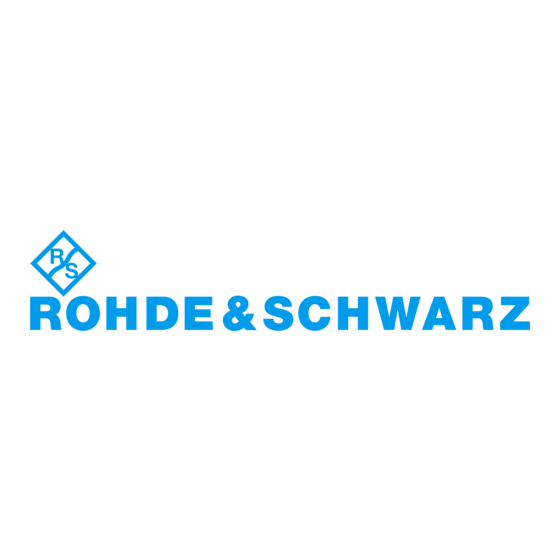

Rohde & Schwarz RTB2000 Getting Started
Digital oscilloscope
Hide thumbs
Also See for RTB2000:
- User manual (547 pages) ,
- Getting started (16 pages) ,
- Manual (2 pages)
Table of Contents
Advertisement
Quick Links
Download this manual
See also:
User Manual
Advertisement
Table of Contents

Summary of Contents for Rohde & Schwarz RTB2000
- Page 1 ® R&S RTB2000 Digital Oscilloscope Getting Started (=Q@52) 1333160502...
- Page 2 Rohde & Schwarz GmbH & Co. KG. Trade names are trademarks of the owners. ® 1333.1605.02 | Version 06 | R&S RTB2000 ® Throughout this manual, products from Rohde & Schwarz are indicated without the symbol , e.g. ® R&S RTB2000 is indicated as R&S RTB2000.
-
Page 3: Table Of Contents
® Contents R&S RTB2000 Contents 1 Safety Information..............5 2 Documentation Overview............7 2.1 Manuals and Instrument Help..............7 2.2 Data Sheet and Brochure..............8 2.3 Calibration Certificate................8 2.4 Release Notes and Open Source Acknowledgment......8 3 Preparing for Use..............9 3.1 Unpacking and Checking the Instrument........... 9 3.2 Positioning the Instrument.............. - Page 4 ® Contents R&S RTB2000 Getting Started 1333.1605.02 ─ 06...
-
Page 5: Safety Information
R&S RTB2000 Safety Information The R&S RTB2000 digital oscilloscope is designed for measurements on circuits that are only indirectly connected to the mains or not connected at all. It is not rated for any measurement category. The instrument is rated for pollution degree 2 - for indoor, dry location use where only non-conductive pollution occurs. - Page 6 ® Safety Information R&S RTB2000 Risk of instrument damage due to inappropriate operating conditions An unsuitable operating site or test setup can damage the instrument and connected devices. Before switching on the instrument, observe the infor- mation on appropriate operating conditions provided in the data sheet. In particular, ensure the following: ●...
-
Page 7: Documentation Overview
You find the manuals on the product page at: www.rohde-schwarz.com/manual/rtb2000 Getting started manual Introduces the R&S RTB2000 and describes how to set up the product. A printed English version is included in the delivery. User manual Contains the description of all instrument modes and functions. It also provides... -
Page 8: Data Sheet And Brochure
(GLORIS, https://gloris.rohde-schwarz.com). Data Sheet and Brochure The data sheet contains the technical specifications of the R&S RTB2000. It also lists the options with their order numbers and optional accessories. The brochure provides an overview of the instrument and deals with the specific characteristics. -
Page 9: Preparing For Use
Delivery contents The delivery package contains the following items: ● R&S RTB2000 digital oscilloscope ● R&S RT-ZP03 probes (2x for R&S RTB2002; 4x for R&S RTB2004) ● Country-specific power cable ● Printed "Getting Started" manual ●... -
Page 10: Positioning The Instrument
® Preparing for Use R&S RTB2000 Positioning the Instrument Positioning the Instrument The instrument is designed for use under laboratory conditions. It can be used in standalone operation on a bench top or can be installed in a rack. For standalone operation, place the instrument on a horizontal bench with even, flat surface. -
Page 11: Starting The Instrument
Starting the Instrument 3.3.1 Powering On The R&S RTB2000 can be used with different AC power voltages and adapts itself automatically to it. The nominal ranges are: ● 100 V to 240 V AC at 50 Hz to 60 Hz ●... -
Page 12: Starting Up And Shutting Down
Starting Up and Shutting Down To start up the instrument 1. Make sure that the R&S RTB2000 is connected to the AC power supply and the main power switch on the rear panel is in position I. 2. Press the [Standby] key. The key is located in the bottom left corner of the front panel. -
Page 13: Powering Off
® Preparing for Use R&S RTB2000 Replacing the Fuse 3.3.3 Powering Off Powering off is required only if the instrument must be disconnected from all power supplies. 1. If the instrument is running, press the [Standby] key on the front panel to shut down the instrument. - Page 14 ® Preparing for Use R&S RTB2000 Replacing the Fuse Risk of electric shock The fuse is part of the main power supply. Therefore, handling the fuse while power is on can lead to electric shock. Before opening the fuse holder, make sure that the instrument is switched off and disconnected from all power supplies.
-
Page 15: Instrument Tour
Instrument Tour Front Panel Figure 4-1 shows the front panel of the R&S RTB2000. The function keys are grouped in functional blocks to the right of the display. Figure 4-1: Front panel of R&S RTB2004 with 4 input channels 1 = Display... -
Page 16: Input Connectors
Input Connectors BNC inputs (4 and 5) The R&S RTB2000 has two or four channel inputs (4) to connect the input sig- nals. The external trigger input (5) is used to control the measurement by an external signal. The trigger level can be set from -5 V to 5 V. -
Page 17: Other Connectors On The Front Panel
The instrument is not rated for any measurement category. When measur- ing in circuits with transient overvoltages of category II, III or IV circuits, make sure that no such overvoltages reach the R&S RTB2000 input. There- fore, use only probes that comply with DIN EN 61010-031. When measur-... -
Page 18: Rear Panel
Multi-purpose BNC output that can function as pass/fail and trigger output, output of 10 MHz reference frequency, and as waveform generator (with option R&S RTB-B6). Rear Panel Figure 4-2 shows the rear panel of the R&S RTB2000 with its connectors. Getting Started 1333.1605.02 ─ 06... - Page 19 Instrument Tour R&S RTB2000 Rear Panel Figure 4-2: Rear panel view of R&S RTB2000 1 = LAN connector 2 = USB connector, type B 3 = AC power supply connector and main power switch 4 = Kensington lock slot to secure the instrument against theft...














Need help?
Do you have a question about the RTB2000 and is the answer not in the manual?
Questions and answers